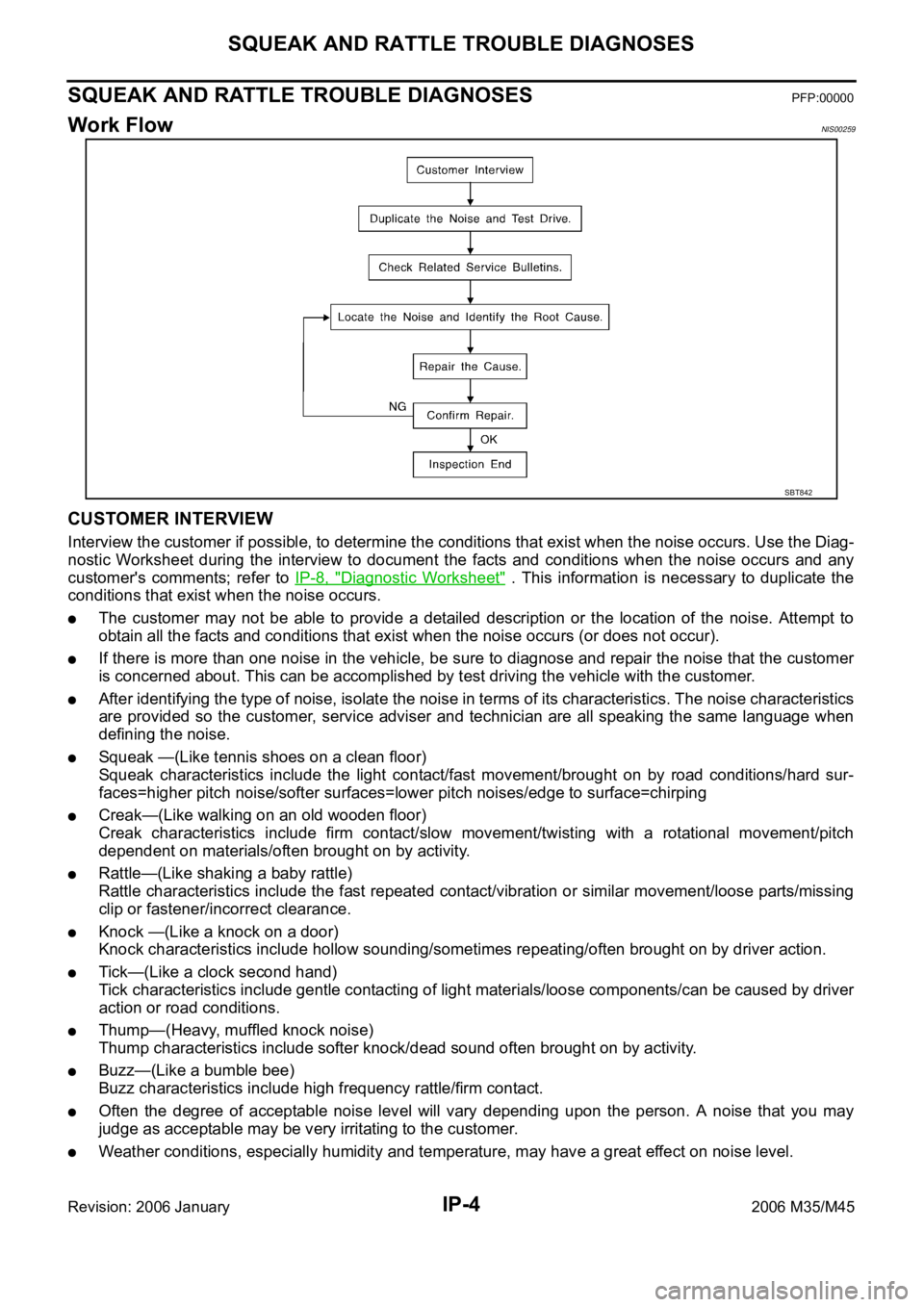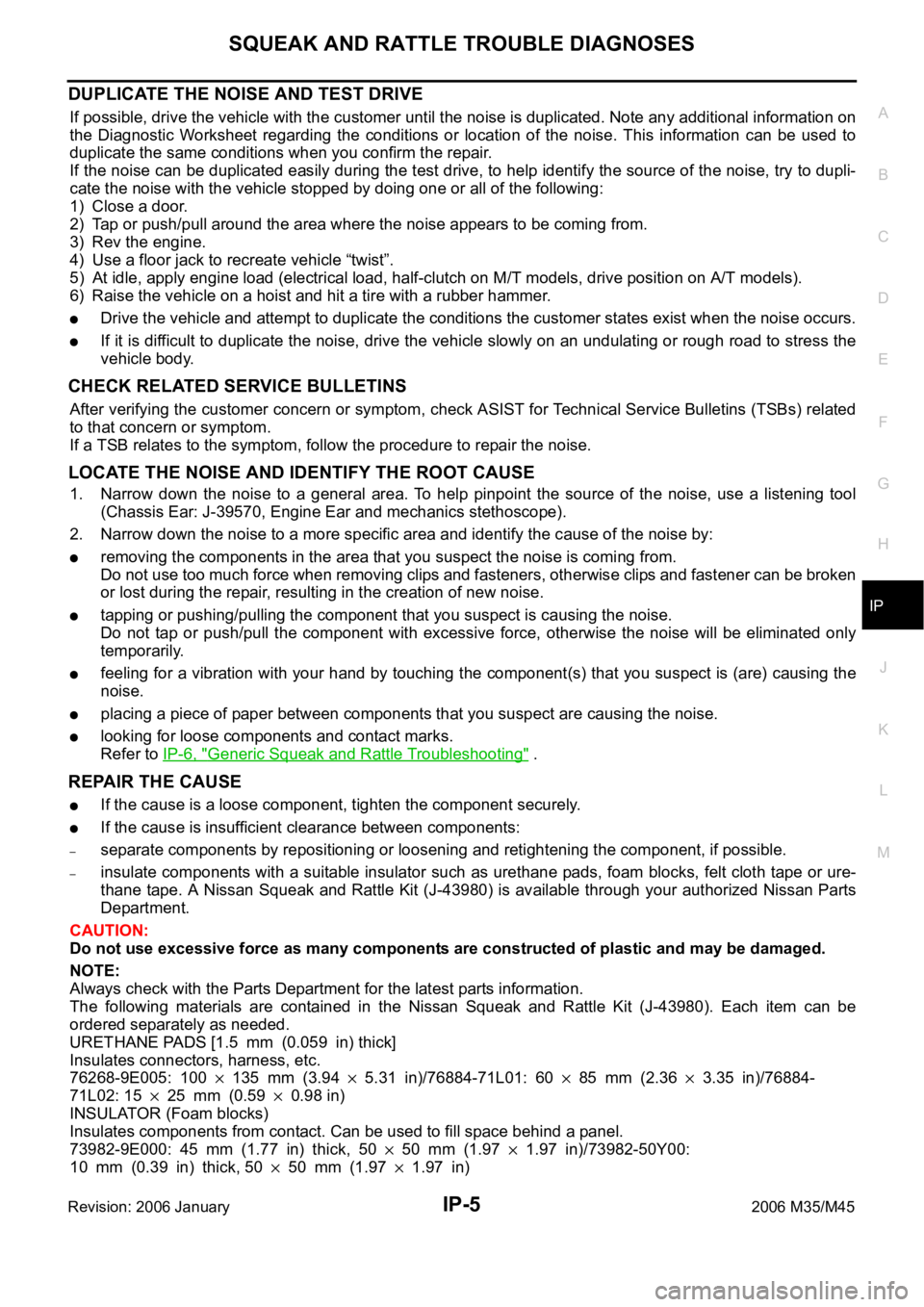2006 INFINITI M35 air condition
[x] Cancel search: air conditionPage 3653 of 5621

IP-4
SQUEAK AND RATTLE TROUBLE DIAGNOSES
Revision: 2006 January2006 M35/M45
SQUEAK AND RATTLE TROUBLE DIAGNOSESPFP:00000
Work FlowNIS00259
CUSTOMER INTERVIEW
Interview the customer if possible, to determine the conditions that exist when the noise occurs. Use the Diag-
nostic Worksheet during the interview to document the facts and conditions when the noise occurs and any
customer's comments; refer to IP-8, "
Diagnostic Worksheet" . This information is necessary to duplicate the
conditions that exist when the noise occurs.
The customer may not be able to provide a detailed description or the location of the noise. Attempt to
obtain all the facts and conditions that exist when the noise occurs (or does not occur).
If there is more than one noise in the vehicle, be sure to diagnose and repair the noise that the customer
is concerned about. This can be accomplished by test driving the vehicle with the customer.
After identifying the type of noise, isolate the noise in terms of its characteristics. The noise characteristics
are provided so the customer, service adviser and technician are all speaking the same language when
defining the noise.
Squeak —(Like tennis shoes on a clean floor)
Squeak characteristics include the light contact/fast movement/brought on by road conditions/hard sur-
faces=higher pitch noise/softer surfaces=lower pitch noises/edge to surface=chirping
Creak—(Like walking on an old wooden floor)
Creak characteristics include firm contact/slow movement/twisting with a rotational movement/pitch
dependent on materials/often brought on by activity.
Rattle—(Like shaking a baby rattle)
Rattle characteristics include the fast repeated contact/vibration or similar movement/loose parts/missing
clip or fastener/incorrect clearance.
Knock —(Like a knock on a door)
Knock characteristics include hollow sounding/sometimes repeating/often brought on by driver action.
Tick—(Like a clock second hand)
Tick characteristics include gentle contacting of light materials/loose components/can be caused by driver
action or road conditions.
Thump—(Heavy, muffled knock noise)
Thump characteristics include softer knock/dead sound often brought on by activity.
Buzz—(Like a bumble bee)
Buzz characteristics include high frequency rattle/firm contact.
Often the degree of acceptable noise level will vary depending upon the person. A noise that you may
judge as acceptable may be very irritating to the customer.
Weather conditions, especially humidity and temperature, may have a great effect on noise level.
SBT842
Page 3654 of 5621

SQUEAK AND RATTLE TROUBLE DIAGNOSES
IP-5
C
D
E
F
G
H
J
K
L
MA
B
IP
Revision: 2006 January2006 M35/M45
DUPLICATE THE NOISE AND TEST DRIVE
If possible, drive the vehicle with the customer until the noise is duplicated. Note any additional information on
the Diagnostic Worksheet regarding the conditions or location of the noise. This information can be used to
duplicate the same conditions when you confirm the repair.
If the noise can be duplicated easily during the test drive, to help identify the source of the noise, try to dupli-
cate the noise with the vehicle stopped by doing one or all of the following:
1) Close a door.
2) Tap or push/pull around the area where the noise appears to be coming from.
3) Rev the engine.
4) Use a floor jack to recreate vehicle “twist”.
5) At idle, apply engine load (electrical load, half-clutch on M/T models, drive position on A/T models).
6) Raise the vehicle on a hoist and hit a tire with a rubber hammer.
Drive the vehicle and attempt to duplicate the conditions the customer states exist when the noise occurs.
If it is difficult to duplicate the noise, drive the vehicle slowly on an undulating or rough road to stress the
vehicle body.
CHECK RELATED SERVICE BULLETINS
After verifying the customer concern or symptom, check ASIST for Technical Service Bulletins (TSBs) related
to that concern or symptom.
If a TSB relates to the symptom, follow the procedure to repair the noise.
LOCATE THE NOISE AND IDENTIFY THE ROOT CAUSE
1. Narrow down the noise to a general area. To help pinpoint the source of the noise, use a listening tool
(Chassis Ear: J-39570, Engine Ear and mechanics stethoscope).
2. Narrow down the noise to a more specific area and identify the cause of the noise by:
removing the components in the area that you suspect the noise is coming from.
Do not use too much force when removing clips and fasteners, otherwise clips and fastener can be broken
or lost during the repair, resulting in the creation of new noise.
tapping or pushing/pulling the component that you suspect is causing the noise.
Do not tap or push/pull the component with excessive force, otherwise the noise will be eliminated only
temporarily.
feeling for a vibration with your hand by touching the component(s) that you suspect is (are) causing the
noise.
placing a piece of paper between components that you suspect are causing the noise.
looking for loose components and contact marks.
Refer to IP-6, "
Generic Squeak and Rattle Troubleshooting" .
REPAIR THE CAUSE
If the cause is a loose component, tighten the component securely.
If the cause is insufficient clearance between components:
–separate components by repositioning or loosening and retightening the component, if possible.
–insulate components with a suitable insulator such as urethane pads, foam blocks, felt cloth tape or ure-
thane tape. A Nissan Squeak and Rattle Kit (J-43980) is available through your authorized Nissan Parts
Department.
CAUTION:
Do not use excessive force as many components are constructed of plastic and may be damaged.
NOTE:
Always check with the Parts Department for the latest parts information.
The following materials are contained in the Nissan Squeak and Rattle Kit (J-43980). Each item can be
ordered separately as needed.
URETHANE PADS [1.5 mm (0.059 in) thick]
Insulates connectors, harness, etc.
76268-9E005: 100
135 mm (3.945.31 in)/76884-71L01: 6085 mm (2.363.35 in)/76884-
71L02: 15
25 mm (0.590.98 in)
INSULATOR (Foam blocks)
Insulates components from contact. Can be used to fill space behind a panel.
73982-9E000: 45 mm (1.77 in) thick, 50
50 mm (1.971.97 in)/73982-50Y00:
10 mm (0.39 in) thick, 50
50 mm (1.971.97 in)
Page 3655 of 5621

IP-6
SQUEAK AND RATTLE TROUBLE DIAGNOSES
Revision: 2006 January2006 M35/M45
INSULATOR (Light foam block)
80845-71L00: 30 mm (1.18 in) thick, 30
50 mm (1.181.97 in)
FELT CLOTHTAPE
Used to insulate where movement does not occur. Ideal for instrument panel applications.
68370-4B000: 15
25 mm (0.590.98 in) pad/68239-13E00: 5 mm (0.20 in) wide tape roll
The following materials, not found in the kit, can also be used to repair squeaks and rattles.
UHMW (TEFLON) TAPE
Insulates where slight movement is present. Ideal for instrument panel applications.
SILICONE GREASE
Used in place of UHMW tape that will be visible or not fit. Will only last a few months.
SILICONE SPRAY
Use when grease cannot be applied.
DUCT TAPE
Use to eliminate movement.
CONFIRM THE REPAIR
Confirm that the cause of a noise is repaired by test driving the vehicle. Operate the vehicle under the same
conditions as when the noise originally occurred. Refer to the notes on the Diagnostic Worksheet.
Generic Squeak and Rattle TroubleshootingNIS0025A
Refer to Table of Contents for specific component removal and installation information.
INSTRUMENT PANEL
Most incidents are caused by contact and movement between:
1. The cluster lid A and instrument panel
2. Acrylic lens and combination meter housing
3. Instrument panel to front pillar garnish
4. Instrument panel to windshield
5. Instrument panel mounting pins
6. Wiring harnesses behind the combination meter
7. A/C defroster duct and duct joint
These incidents can usually be located by tapping or moving the components to duplicate the noise or by
pressing on the components while driving to stop the noise. Most of these incidents can be repaired by apply-
ing felt cloth tape or silicon spray (in hard to reach areas). Urethane pads can be used to insulate wiring har-
ness.
CAUTION:
Do not use silicone spray to isolate a squeak or rattle. If you saturate the area with silicone, you will
not be able to recheck the repair.
CENTER CONSOLE
Components to pay attention to include:
1. Shifter assembly cover to finisher
2. A/C control unit and cluster lid C
3. Wiring harnesses behind audio and A/C control unit
The instrument panel repair and isolation procedures also apply to the center console.
DOORS
Pay attention to the:
1. Finisher and inner panel making a slapping noise
2. Inside handle escutcheon to door finisher
3. Wiring harnesses tapping
4. Door striker out of alignment causing a popping noise on starts and stops
Tapping or moving the components or pressing on them while driving to duplicate the conditions can isolate
many of these incidents. You can usually insulate the areas with felt cloth tape or insulator foam blocks from
the Nissan Squeak and Rattle Kit (J-43980) to repair the noise.
Page 3656 of 5621

SQUEAK AND RATTLE TROUBLE DIAGNOSES
IP-7
C
D
E
F
G
H
J
K
L
MA
B
IP
Revision: 2006 January2006 M35/M45
TRUNK
Trunk noises are often caused by a loose jack or loose items put into the trunk by the owner.
In addition look for:
1. Trunk lid dumpers out of adjustment
2. Trunk lid striker out of adjustment
3. The trunk lid torsion bars knocking together
4. A loose license plate or bracket
Most of these incidents can be repaired by adjusting, securing or insulating the item(s) or component(s) caus-
ing the noise.
SUNROOF/HEADLINING
Noises in the sunroof/headlining area can often be traced to one of the following:
1. Sunroof lid, rail, linkage or seals making a rattle or light knocking noise
2. Sunvisor shaft shaking in the holder
3. Front or rear windshield touching headlining and squeaking
Again, pressing on the components to stop the noise while duplicating the conditions can isolate most of these
incidents. Repairs usually consist of insulating with felt cloth tape.
SEATS
When isolating seat noise it's important to note the position the seat is in and the load placed on the seat when
the noise is present. These conditions should be duplicated when verifying and isolating the cause of the
noise.
Cause of seat noise include:
1. Headrest rods and holder
2. A squeak between the seat pad cushion and frame
3. The rear seatback lock and bracket
These noises can be isolated by moving or pressing on the suspected components while duplicating the con-
ditions under which the noise occurs. Most of these incidents can be repaired by repositioning the component
or applying urethane tape to the contact area.
UNDERHOOD
Some interior noise may be caused by components under the hood or on the engine wall. The noise is then
transmitted into the passenger compartment.
Causes of transmitted underhood noise include:
1. Any component mounted to the engine wall
2. Components that pass through the engine wall
3. Engine wall mounts and connectors
4. Loose radiator mounting pins
5. Hood bumpers out of adjustment
6. Hood striker out of adjustment
These noises can be difficult to isolate since they cannot be reached from the interior of the vehicle. The best
method is to secure, move or insulate one component at a time and test drive the vehicle. Also, engine RPM
or load can be changed to isolate the noise. Repairs can usually be made by moving, adjusting, securing, or
insulating the component causing the noise.
Page 3679 of 5621
![INFINITI M35 2006 Factory Service Manual LAN-10
[CAN]
TROUBLE DIAGNOSES WORK FLOW
Revision: 2006 January2006 M35/M45
TROUBLE DIAGNOSIS FLOW CHART
Depending on the control unit which performs CAN communication, “U1010” may be indicated as INFINITI M35 2006 Factory Service Manual LAN-10
[CAN]
TROUBLE DIAGNOSES WORK FLOW
Revision: 2006 January2006 M35/M45
TROUBLE DIAGNOSIS FLOW CHART
Depending on the control unit which performs CAN communication, “U1010” may be indicated as](/manual-img/42/57023/w960_57023-3678.png)
LAN-10
[CAN]
TROUBLE DIAGNOSES WORK FLOW
Revision: 2006 January2006 M35/M45
TROUBLE DIAGNOSIS FLOW CHART
Depending on the control unit which performs CAN communication, “U1010” may be indicated as the result of
self-diagnosis. Replace the control unit if “U1010” is indicated.
Step 1: Refer to LAN-11, "SELECTING CAN SYSTEM TYPE (HOW TO USE SPECIFICATION TABLE)" .
Step 2: Refer to LAN-12, "ACQUISITION OF DATA BY CONSULT-II" .
Step 3: Refer to LAN-14, "HOW TO USE CHECK SHEET TABLE" .
Step 4: Refer to LAN-15, "Example of Filling in Check Sheet When Initial Conditions Are Reproduced" .
Step 5: Check and repair according to system diagnosis.
PKIC0260E
Page 3684 of 5621
![INFINITI M35 2006 Factory Service Manual TROUBLE DIAGNOSES WORK FLOW
LAN-15
[CAN]
C
D
E
F
G
H
I
J
L
MA
B
LAN
Revision: 2006 January2006 M35/M45
Example of Filling in Check Sheet When Initial Conditions Are Reproduced
1. Put a check mark to � INFINITI M35 2006 Factory Service Manual TROUBLE DIAGNOSES WORK FLOW
LAN-15
[CAN]
C
D
E
F
G
H
I
J
L
MA
B
LAN
Revision: 2006 January2006 M35/M45
Example of Filling in Check Sheet When Initial Conditions Are Reproduced
1. Put a check mark to �](/manual-img/42/57023/w960_57023-3683.png)
TROUBLE DIAGNOSES WORK FLOW
LAN-15
[CAN]
C
D
E
F
G
H
I
J
L
MA
B
LAN
Revision: 2006 January2006 M35/M45
Example of Filling in Check Sheet When Initial Conditions Are Reproduced
1. Put a check mark to “No indication” if some of unit names listed on the column of diagnosis system selec-
tion screen of a check sheet table are not displayed on “SELECT SYSTEM” screen attached to the check
sheet.
NOTE:
Put a check mark to “No indication” of BCM and AUTO DRIVE POS. because BCM and AUTO DRIVE
POS. is not displayed on “SELECT SYSTEM” screen.
2. Confirm the unit name that “UNKWN” is displayed from the copy of “CAN DIAG SUPPORT MNTR” screen
of “ENGINE” attached to the check sheet, and then put a check mark to the check sheet table.
NOTE:
In “CAN DIAG SUPPORT MNTR” screen, “UNKWN” is displayed on “VDC/TCS/ABS”, “METER/M&A” and
“IPDM E/R”. Put a check mark to it.
3. Confirm the unit name that “UNKWN” is displayed on the copy of “CAN DIAG SUPPORT MNTR” screen
of “A/T” and “AIR PRESSURE MONITOR” as well as “ENGINE”. And then, put a check mark to the check
sheet table.
NOTE:
For “A/T”, “UNKWN” is displayed on “VDC/TCS/ABS”, “METER/M&A”, “ICC/e4WD” and “AWD/4WD”.
But put a check mark to “VDC/TCS/ABS” and “METER/M&A” because “UNKWN” is listed on the col-
umn of reception diagnosis of the check sheet table.
For “AIR PRESSURE MONITOR”, “UNKWN” is displayed on “ECM”. Put a check mark to it.
PKIC0265E
Page 3687 of 5621
![INFINITI M35 2006 Factory Service Manual LAN-18
[CAN]
TROUBLE DIAGNOSES WORK FLOW
Revision: 2006 January2006 M35/M45
Example of Filling in Check Sheet When Initial Conditions Are Not Reproduced
1. See “SELF-DIAG RESULTS” of all units att INFINITI M35 2006 Factory Service Manual LAN-18
[CAN]
TROUBLE DIAGNOSES WORK FLOW
Revision: 2006 January2006 M35/M45
Example of Filling in Check Sheet When Initial Conditions Are Not Reproduced
1. See “SELF-DIAG RESULTS” of all units att](/manual-img/42/57023/w960_57023-3686.png)
LAN-18
[CAN]
TROUBLE DIAGNOSES WORK FLOW
Revision: 2006 January2006 M35/M45
Example of Filling in Check Sheet When Initial Conditions Are Not Reproduced
1. See “SELF-DIAG RESULTS” of all units attached to the check sheet. If “CAN COMM CIRCUIT [U1000]”
or “CAN COMM CIRCUIT [U1001]” is displayed, put a check mark to the applicable column of self-diag-
nostic results of the check sheet table.
NOTE:
For “ENGINE”, “CAN COMM CIRCUIT [U1001]” are displayed. Put a check mark to it.
For “A/T”, “CAN COMM CIRCUIT [U1000]” are displayed. Put a check mark to it.
For “BCM”, “CAN COMM CIRCUIT [U1000]” is displayed. Put a check mark to it.
For “AIR PRESSURE MONITOR”, “CAN COMM CIRCUIT [U1000]” is displayed. Put a check mark to it.
For “INTELLIGENT KEY”, “CAN COMM CIRCUIT [U1000]” is displayed. Put a check mark to it.
For “METER A/C AMP”, “CAN COMM CIRCUIT [U1000]” are displayed. Put a check mark to it.
For “MULTI AV”, “CAN COMM CIRCUIT [U1000]” is displayed. Put a check mark to it.
For “AUTO DRIVE POS.”, “NO DTC IS DETECTED” are displayed. Do not put a check mark to it.
For “ABS”, “CAN COMM CIRCUIT [U1000]” are displayed. Put a check mark to it.
For “IPDM E/R”, “CAN COMM CIRCUIT [U1000]” is displayed. Put a check mark to it.
PKIC0268E
Page 3694 of 5621
![INFINITI M35 2006 Factory Service Manual TROUBLE DIAGNOSES WORK FLOW
LAN-25
[CAN]
C
D
E
F
G
H
I
J
L
MA
B
LAN
Revision: 2006 January2006 M35/M45
DESCRIPTION OF “CAN DIAG SUPPORT MNTR” SCREEN
FOR LOW TIRE PRESSURE WARNING CONTROL UNIT
Dis INFINITI M35 2006 Factory Service Manual TROUBLE DIAGNOSES WORK FLOW
LAN-25
[CAN]
C
D
E
F
G
H
I
J
L
MA
B
LAN
Revision: 2006 January2006 M35/M45
DESCRIPTION OF “CAN DIAG SUPPORT MNTR” SCREEN
FOR LOW TIRE PRESSURE WARNING CONTROL UNIT
Dis](/manual-img/42/57023/w960_57023-3693.png)
TROUBLE DIAGNOSES WORK FLOW
LAN-25
[CAN]
C
D
E
F
G
H
I
J
L
MA
B
LAN
Revision: 2006 January2006 M35/M45
DESCRIPTION OF “CAN DIAG SUPPORT MNTR” SCREEN
FOR LOW TIRE PRESSURE WARNING CONTROL UNIT
Display Results (Present)
OK: Normal
UNKWN: The diagnosed unit does not transmit or receive the applicable data normally.
–: There is no received unit or the unit is not in the condition that reception diagnosis is performed.
Display Results (Past)
OK: Normal
0: There is malfunction now.
1 ~ 39: Displays when it is normal at present and finds malfunction in the past. It increases like 012...3839 after returning to the
normal condition whenever IGN OFF
ON. If it is over 39, it is fixed to 39 until the self-diagnostic results are erased. It returns to 0
when malfunction is detected again in the process.
–: Undiagnosed
PKIB9797E
“SELECT SYSTEM”
screen“CAN DIAG SUP-
PORT MNTR”
screenDescription Present Past
AIR PRESSURE
MONITORTRANSMIT DIAG Make sure of normal transmission. OK/UNKWN/–
OK/0/1~39/– ECM Make sure of normal reception from ECM. OK/UNKWN/–
VDC/TCS/ABSMake sure of normal reception from ABS actuator and
electric unit (control unit).OK/UNKWN/–